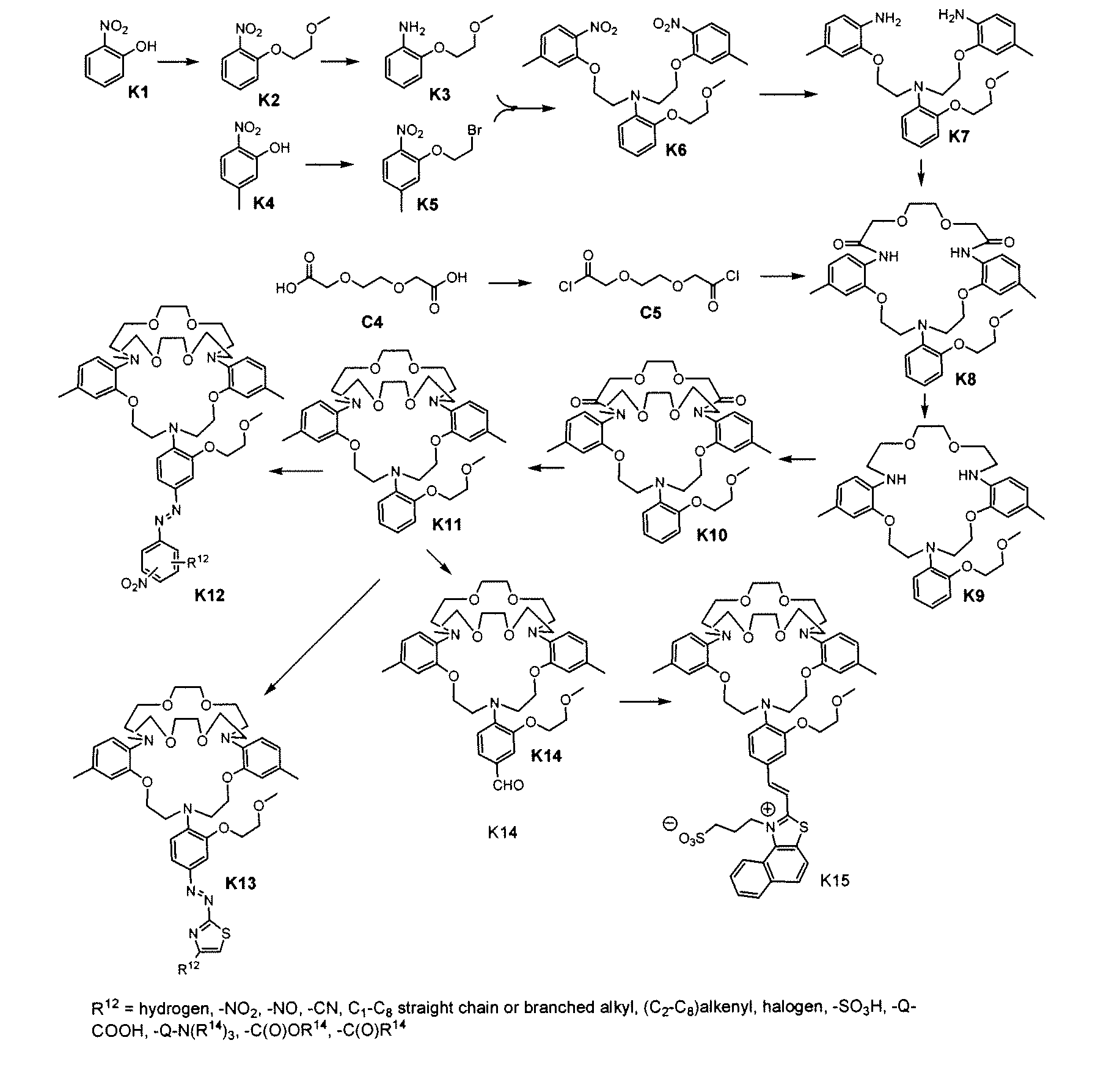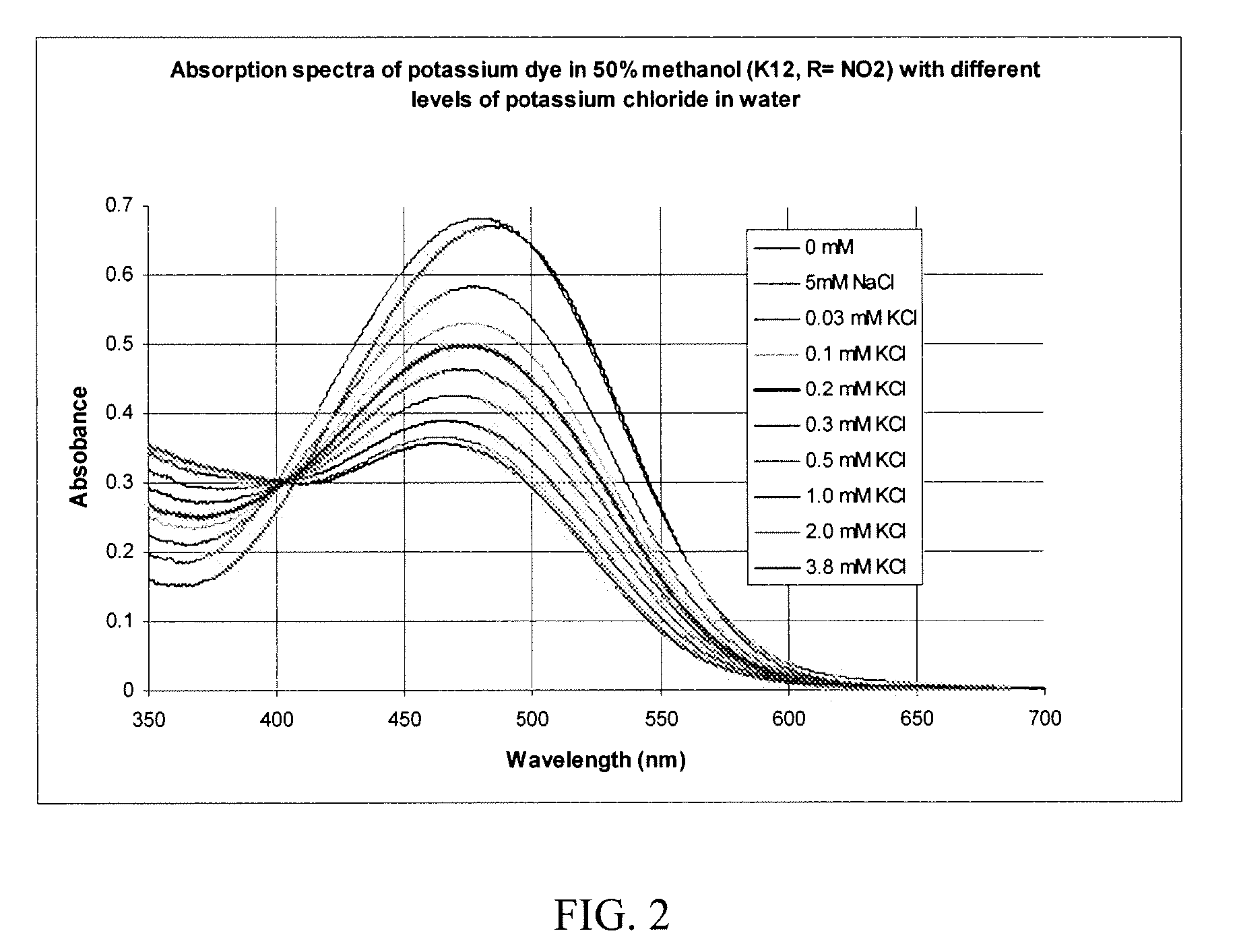Chromoionophore and method of determining potassium ions
- Summary
- Abstract
- Description
- Claims
- Application Information
AI Technical Summary
Benefits of technology
Problems solved by technology
Method used
Image
Examples
example 1
[0081] Synthesis of K5. 122.5 g (800 mmol) 5-methyl-2-nitrophenol (K4), 751.0 g (4000 mmol) 1,2-dibromoethane, 110.7 g (800 mmol) K2CO3 were suspended in 400 mL anhydrous DMF. Heated at 120° C. for 1 hour, cooled, and most of the liquid was evaporated. The residue was dissolved in 1 L CHCl3 and 1 L water. The organic layer washed with 2×1 1.8% NaOH until the aqueous layer became pale yellow. The organic layer was dried over Na2SO4. Filtered and the solvent was evaporated to give ˜240 g oil. The oil was triturated with 240 mL boiling methanol and allowed to sit for 2 hours. The resulting precipitate was filtered and washed with 2×100 mL cold methanol, dried at room temperature for 18 h to afford 103.4 g off-white crystal with a melting point 45-47° C. H1NMR (300 MHz, CDCl3) δ (ppm): 2.40 (s, 3H, Ar—CH3), 3.65 (t, 2H, CH2Br), 4.30 (t, 2H, ArOCH2), 6.85-7.75 (m, 3H, Ar—H). Anal. Calcd for C9H10BrNO3: C, 41.56; H, 3.88; N, 5.39. Found: C, 41.96; H, 3.92; N, 5.53.
example 2
[0082] Synthesis of K2. A suspension of 140 g (1010 mmol) 2-nitrophenol (K1), 105 g (1110 mmol) chloroethyl methyl ether, 84.2 g (507 mmol) KI, 153 g (1110 mmol) K2CO3 and 500 mL DMF was heated at 110±5° C. for 6 h. Solvent was evaporated and the residue was dissolved in 500 mL CHCl3 and 500 mL water. Organic phase washed with 2×500 mL 2.5% Na2CO3, 500 mL sat. NaCl, dried over Na2SO4. The solvent was evaporated to afford 161 g light yellow oil. H1NMR (300 MHz, CDCl3) δ (ppm) 3.45 (s, 3H, OCH3), 3.78 (t, 2H, OCH2), 4.25 (t, 2H, ArOCH2), 7.02-7.82 (m, 4H, Ar—H). Anal. Calcd for C9H11NO4: C, 54.82; H, 5.62; N, 7.10. Found: C, 54.63; H, 5.82; N, 7.43.
example 3
[0083] Synthesis of K3. 60.5 g (30.7 mmol) K2 was dissolved in 200 mL methanol, 3.0 g 10% palladium on activated carbon was added. This suspension was hydrogenated at 2.2 atm. for 18 h, until no more hydrogen uptake was observed. The catalyst was filtered off and the solvent was evaporated to afford 48.7 g light yellow oil. H1NMR (300 MHz, CDCl3) δ (ppm) 3.45 (s, 3H, OCH3), 3.65 (br. s, 2H, Ar—NH2), 3.78 (t, 2H, OCH2), 4.20 (t, 2H, ArOCH2), 6.74-6.82 (m, 4H, Ar—H). Anal. Calcd for C9H13NO2: C, 64.65; H, 7.84; N, 8.38. Found: C, 64.27; H, 8.08; N, 8.58.
PUM
 Login to View More
Login to View More Abstract
Description
Claims
Application Information
 Login to View More
Login to View More - R&D Engineer
- R&D Manager
- IP Professional
- Industry Leading Data Capabilities
- Powerful AI technology
- Patent DNA Extraction
Browse by: Latest US Patents, China's latest patents, Technical Efficacy Thesaurus, Application Domain, Technology Topic, Popular Technical Reports.
© 2024 PatSnap. All rights reserved.Legal|Privacy policy|Modern Slavery Act Transparency Statement|Sitemap|About US| Contact US: help@patsnap.com










